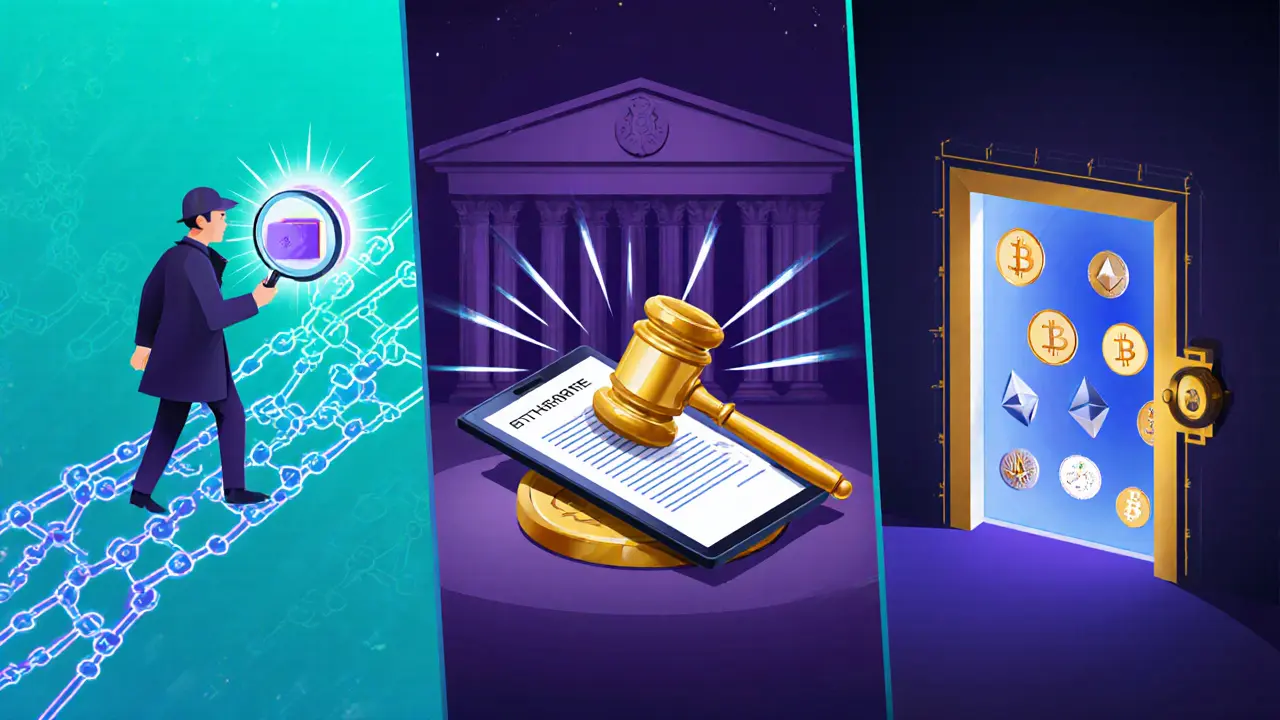Crypto Seizure Risk Calculator
Risk Assessment
See how your cryptocurrency holdings might be affected by jurisdiction-specific seizure policies
Risk Assessment Results
When governments move to confiscate digital assets, cryptocurrency seizure is the legal process of taking ownership of crypto holdings linked to illegal activity. In 2025 the practice has turned from a niche enforcement tool into a major policy lever, reshaping how nations protect victims, fund law‑enforcement budgets, and even hedge against inflation.
Key Takeaways
- The United States launched the Strategic Bitcoin Reserve, holding over 207,000 BTC ($17 billion) as a sovereign asset.
- Europe leads in Ethereum and stablecoin seizures, while North America dominates Bitcoin and altcoin theft.
- International cooperation is growing - the Spanish Guardia Civil’s 2025 operation is a prime example.
- Regulatory trends treat digital assets as "property," allowing traditional forfeiture statutes to apply.
- Investors should monitor jurisdiction‑specific seizure policies to manage compliance risk.
How Asset Forfeiture of Crypto Works Worldwide
Most jurisdictions now classify cryptocurrencies as property rather than currency. That shift enables prosecutors to apply existing forfeiture statutes, which were originally designed for cash, vehicles, or real‑estate. In practice, a seizure follows three steps:
- Identification: Law‑enforcement agencies trace blockchain transactions to a wallet linked to a crime.
- Legal Process: Courts issue confiscation orders, often after criminal convictions or civil asset‑forfeiture proceedings.
- Disposition: Assets may be liquidated, auctioned, or, increasingly, retained for strategic purposes.
Technical hurdles-such as extracting private keys or navigating decentralized finance (DeFi) protocols-are now addressed by specialized units like the U.S. Cyber and Emerging Technologies Unit.
Country‑by‑Country Spotlight
Below is a snapshot of how the most active jurisdictions handle forfeiture and notable 2025 seizures.
| Country | Legal Status of Crypto | Seizure Policy | Notable 2025 Seizure |
|---|---|---|---|
| United States | Legal, regulated as property | Retention in Strategic Bitcoin Reserve; victim restitution prioritized | 207,000 BTC (≈ $17 B) moved to the Reserve on March 6 2025 |
| Spain | Legal, subject to AML/KYC rules | Seizure via Guardia Civil; coordination with U.S. agencies | USD 250 M worth of Bitcoin from a ransomware gang |
| Germany | Legal, regulated by BaFin | Court‑ordered liquidation; proceeds fund victim compensation | €120 M in Ethereum linked to phishing attacks |
| Russia | Legal with heavy licensing | State‑controlled confiscation; assets often transferred to state‑run funds | 15 BTC seized from an offshore mixer operation |
| Canada | Legal, treated as taxable property | Seizure followed by public auction | CAD 5 M in stablecoins frozen in a Ponzi scheme |
| Japan | Legal, regulated by FSA | Seizure with mandatory reporting to Financial Services Agency | ¥1.2 B worth of Bitcoin from a crypto‑exchange hack |
| United Arab Emirates | Legal, free‑zone incentives | Retention for state‑owned investment funds | US$300 M in NFTs seized from a money‑laundering ring |
| India | Legal but with pending tax guidance | Seizure followed by tax assessment | ₹1.5 B in altcoins from a pyramid scheme |

Enforcement Patterns and Statistics
Data from the first half of 2025 shows $2.17 billion stolen from crypto services-more than the entire previous year. The geographic spread is telling:
- North America leads in Bitcoin and altcoin theft, reflecting high adoption and large individual holdings.
- Europe dominates Ethereum and stablecoin theft, suggesting attackers target liquid, ERC‑20 assets.
- APAC (Asia‑Pacific) ranks second for total BTC stolen and third for ETH.
- Eastern Europe, MENA, and CSAO (Central‑South Asia & Oceania) posted the fastest victim‑growth rates, indicating expanding criminal networks.
Victim‑severity analysis highlights the United Arab Emirates, Chile, India, Lithuania, Iran, Israel, and Norway as the countries where each victim lost the most value on average.
International Cooperation in Action
A landmark operation in March 2025 saw Spain’s Guardia Civil collaborate with U.S. agencies to seize Bitcoin tied to a ransomware group operating across three continents. The joint effort demonstrated two emerging trends:
- Cross‑border legal frameworks are being harmonized, allowing evidence sharing without lengthy extradition battles.
- Seized assets are increasingly pooled into multinational funds that support victim restitution across jurisdictions.
Other cooperative initiatives include the EU’s “Crypto Asset Recovery Network” and the Inter‑Agency Crypto Task Force led by the U.S. Department of Justice.

Policy Implications and Future Outlook
Retaining seized crypto rather than liquidating it serves multiple policy goals:
- Market stability: Avoids a sudden flood of supply that could crash prices.
- Revenue generation: Appreciating assets fund future enforcement actions and victim restitution.
- Strategic reserve: Countries like the United States treat the Strategic Bitcoin Reserve as a hedge against inflation.
However, critics argue that holding assets raises due‑process concerns and may blur the line between law‑enforcement and sovereign wealth management. Upcoming reforms in the U.S. Congress aim to add transparency safeguards, while the European Union is drafting guidelines for the disposal of seized digital assets.
Practical Guidance for Investors and Compliance Teams
If you operate a crypto‑related business or hold sizable personal crypto assets, consider these steps:
- Know your jurisdiction’s seizure law: Review whether crypto is treated as property, a commodity, or a separate asset class.
- Implement robust KYC/AML controls: Strong identity verification reduces the risk of becoming a target for confiscation.
- Secure private keys offline: Cold‑storage wallets make it harder for authorities to access assets without a court order.
- Maintain clear audit trails: Transaction logs help demonstrate legitimate source of funds if questioned.
- Plan for possible restitution: Some jurisdictions require seized assets to be returned to victims; having a restitution policy can mitigate reputational damage.
Staying informed about policy shifts-especially in major markets like the United States, Europe, and the United Arab Emirates-will help you navigate the evolving regulatory landscape.
Frequently Asked Questions
What does "crypto seizure" mean in legal terms?
A crypto seizure is a court‑issued order that transfers ownership of digital assets from an individual or entity to the state because the assets are linked to criminal conduct or regulatory violations.
How does the Strategic Bitcoin Reserve affect the market?
By holding rather than immediately liquidating seized Bitcoin, the Reserve prevents a sudden supply shock that could depress prices. It also lets the U.S. benefit from any future appreciation.
Can crypto assets be seized without a criminal conviction?
Yes. In several countries, civil asset‑forfeiture laws allow authorities to seize property suspected of being linked to crime, even before a conviction.
What are the main differences between U.S. and EU seizure policies?
The U.S. now prefers retention in a sovereign reserve, whereas the EU tends to order liquidation and direct victim restitution. The EU also emphasizes cross‑border cooperation through the Crypto Asset Recovery Network.
How can businesses protect themselves from future seizures?
Adopt strong compliance programs, keep transparent records, and store private keys offline. Regular legal reviews ensure policies stay in line with the latest jurisdictional rules.


16 Responses
Wow, the government now treats Bitcoin like a national piggy bank – because why let private people have fun with it? 🙃
The strategic reserve could actually smooth out market volatility, since a sudden dump would be avoided :) It also gives law‑enforcement a new lever for negotiations with criminals.
For organizations operating in multiple jurisdictions, it is essential to map each country’s classification of crypto as property, commodity, or otherwise, then align compliance policies accordingly. A formal risk‑assessment matrix can help prioritize jurisdictions where seizure risk is highest.
Great overview! A quick tip: keep your private keys on air‑gapped hardware wallets and maintain an immutable audit log of all transactions. If you ever face a seizure order, that paperwork will be your best defense – and it also speeds up restitution for victims.
From a cultural‑policy perspective, the emergence of sovereign crypto reserves signals a paradigm shift; nations are no longer merely regulators but active participants in the digital‑asset ecosystem, leveraging blockchain’s transparency to enhance fiscal resilience, diversify treasury holdings, and project geopolitical influence; this transformation is underpinned by a confluence of legal reinterpretation-treating crypto as property-technological capability-advanced forensic tracing-and strategic imperatives-mitigating illicit finance while capitalizing on market appreciation; moreover, the cross‑border cooperation exemplified by Spain’s Guardia Civil and U.S. agencies establishes a template for multilateral frameworks, fostering standardized evidentiary protocols and shared intelligence platforms, which in turn reduces duplication of effort and accelerates asset recovery; the data also reveal regional patterns: North America dominates Bitcoin confiscations due to high on‑ramp activity, Europe leads in Ethereum and stablecoin seizures reflecting DeFi penetration, and APAC’s rising BTC theft rates correspond with expanding retail adoption; such granularity enables compliance teams to tailor KYC/AML controls, prioritize monitoring of high‑risk token types, and allocate investigative resources strategically; furthermore, the policy debate surrounding asset retention versus liquidation touches on core economic principles-supply‑side shock avoidance versus immediate fiscal influx-and raises questions about the appropriate stewardship of seized assets, especially when they become de‑facto sovereign wealth components; critics argue that opaque retention policies could blur lines between law‑enforcement and state investment, potentially eroding public trust, while proponents highlight the hedging benefits against inflationary pressures; upcoming legislative reforms in the U.S. aim to embed transparency safeguards, and the EU’s draft guidelines seek to harmonize disposal procedures, indicating a maturing regulatory ecosystem; for investors, the key takeaway is to maintain robust compliance pipelines, secure offline key storage, and stay attuned to jurisdiction‑specific seizure statutes, as these factors will increasingly shape risk‑adjusted returns in the crypto space.
That deep‑dive really underscores why you need a solid compliance playbook; once you have a clear audit trail, you’re better positioned to argue for legitimate ownership if a seizure ever comes knocking.
Staying ahead of the curve is the best defense – and remember, a supportive community can help you navigate those tough legal waters. 🌟
While the macro‑policy trends are fascinating, the practical takeaway for everyday users is to adopt multi‑layered security and keep abreast of local forfeiture statutes; both steps mitigate exposure without sacrificing operational efficiency.
If the state starts hoarding crypto, we must ask whether wealth is being redistributed or simply re‑packed for future power plays. The answer isn’t simple, but the principle of property rights remains central.
One can’t ignore the shadowy undercurrents: every sovereign reserve is a potential lever for covert financial manipulation, hidden behind layers of legal jargon and encrypted ledgers, turning public policy into an arena for elite agenda‑setting.
Seizing assets is fine when it protects victims, but turning them into profit centers for governments borders on moral corruption – we must hold authorities accountable.
Keep doing the right thing, stay alert, and don’t let fear stop you from using crypto safely.
Interesting data, shows how global the issue really is.
Our nation’s crypto should stay American.
It’s important to respect jurisdictional boundaries while fostering international cooperation for asset recovery.
Great insights-remember to keep your keys offline and maintain a clear audit trail; those steps will serve you well if any seizure request arises.